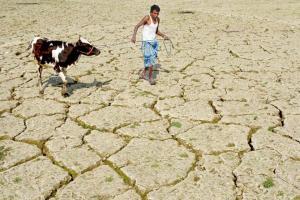The study, published in the journal Nature, compared predicted and real-world soil moisture data to look for human influences on global drought patterns in the 20th century

Representation pic
A new study has claimed that greenhouse gases and atmospheric particles generated by human beings were affecting the worldwide drought risk as far back as the early 20th century.
ADVERTISEMENT
The study, published in the journal Nature, compared predicted and real-world soil moisture data to look for human influences on global drought patterns in the 20th century.
Climate models predicted that a human 'fingerprint' - a global pattern of regional drying and wetting characteristic of the climate response to greenhouse gases - should be visible early in the 1900s and increase over time as emissions increased.
Using observational data such as precipitation and historical data reconstructed from tree rings, the researchers found that the real-world data began to align with the fingerprint within the first half of the 20th century.
The team said the study is the first to provide historical evidence connecting human-generated emissions and drought at near-global scales, lending credibility to forward-looking models that predict such a connection.
According to the research, the fingerprint is likely to grow stronger over the next few decades, potentially leading to severe human consequences.
The study's key drought indicator was the Palmer Drought Severity Index or PDSI. The PDSI averages soil moisture over the summer months using data such as precipitation, air temperature, and runoff.
While today NASA measures soil moisture from space, these measurements only date back to 1980. The PDSI provides researchers with average soil moisture over long periods of time, making it especially useful for research on climate change in the past.
The team also used drought atlases: Maps of where and when droughts happened throughout history, calculated from tree rings.
"These records go back centuries. We have a comprehensive picture of global drought conditions that stretch back way into history, and they are amazingly high quality," said lead author Kate Marvel.
Taken together, modern soil moisture measurements and tree-ring-based records of the past create a data set that the team compared to the models.
They also calibrated their data against climate models run with atmospheric conditions similar to those in 1850, before the Industrial Revolution brought increases in greenhouse gases and air pollution.
"We were pretty surprised that you can see this human fingerprint, this human climate change signal, emerge in the first half of the 20th century," said Ben Cook, who co-led the study with Marvel. The story changed briefly between 1950 and 1975, as the atmosphere became cooler and wetter.
The team believes this was due to aerosols, or particles in the atmosphere. Before the passage of air quality legislation, industry expelled vast quantities of smoke, soot, sulfur dioxide and other particles that researchers believe blocked sunlight and counteracted greenhouse gases' warming effects during this period. Aerosols are harder to model than greenhouse gases, however, so while they are the most likely culprit, the team cautioned that further research is necessary to establish a definite link.
After 1975, as pollution declined, global drought patterns began to trend back toward the fingerprint. It does not yet match closely enough for the team to say statistically that the signal has reappeared, but they agree that the data trends in that direction.
What made this study innovative is seeing the big picture of global drought, Marvel said.
Individual regions can have significant natural variability year to year, making it difficult to tell whether a drying trend is due to human activity. Combining many regions into a global drought atlas meant there was a stronger signal if droughts happened in several places simultaneously.
Previous assessments from national and international climate organizations have not directly linked trends in global-scale drought patterns to human activities, Cook said, mainly due to lack of data supporting that link.
He suggested that, by demonstrating a human fingerprint on droughts in the past, this study provides evidence that human activities could continue to influence droughts in the future.
Models predict that droughts will become more frequent and severe as temperatures rise, potentially causing food and water shortages, human health impacts, destructive wildfires and conflicts between peoples competing for resources.
"Climate change is not just a future problem. This shows it's already affecting global patterns of drought, hydroclimate, trends, variability -- it's happening now. And we expect these trends to continue, as long as we keep warming the world," said Cook.
Catch up on all the latest Crime, National, International and Hatke news here. Also download the new mid-day Android and iOS apps to get latest updates
 Subscribe today by clicking the link and stay updated with the latest news!" Click here!
Subscribe today by clicking the link and stay updated with the latest news!" Click here!






